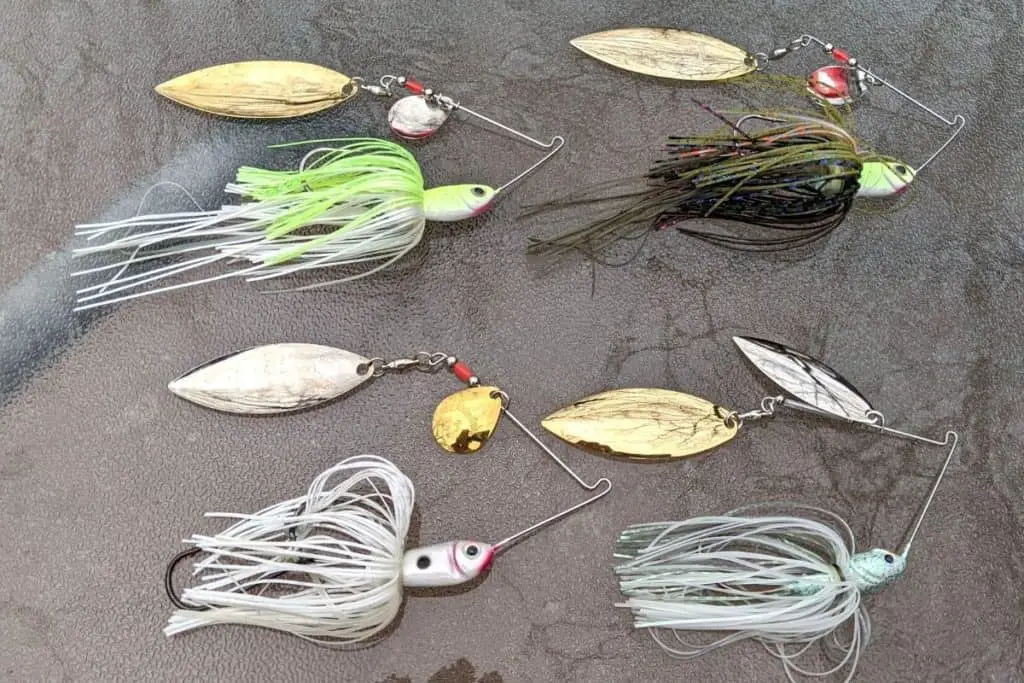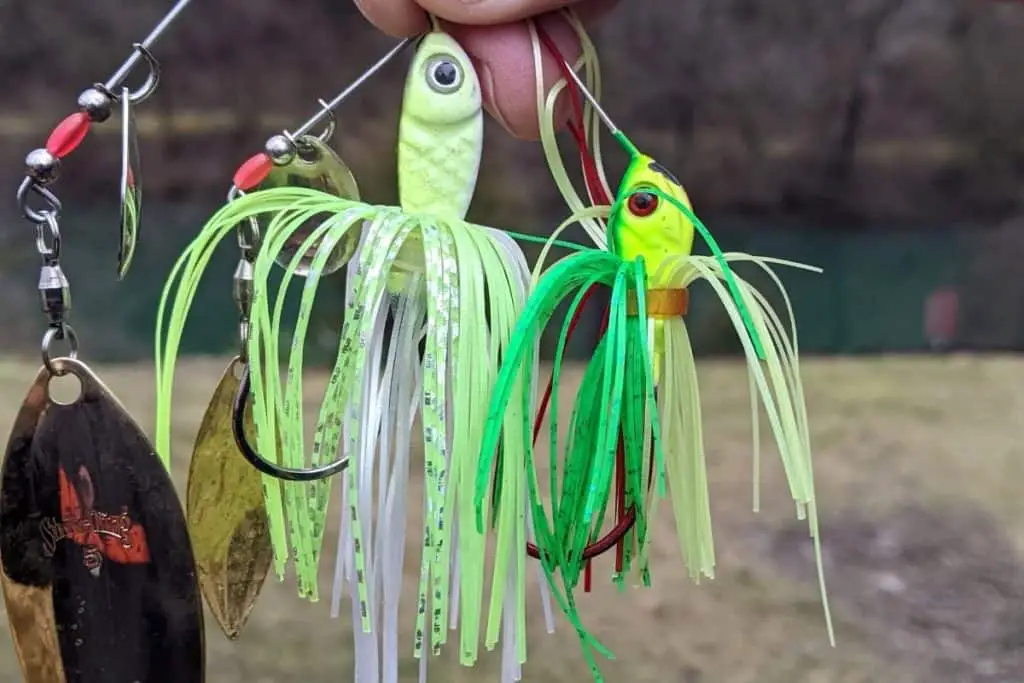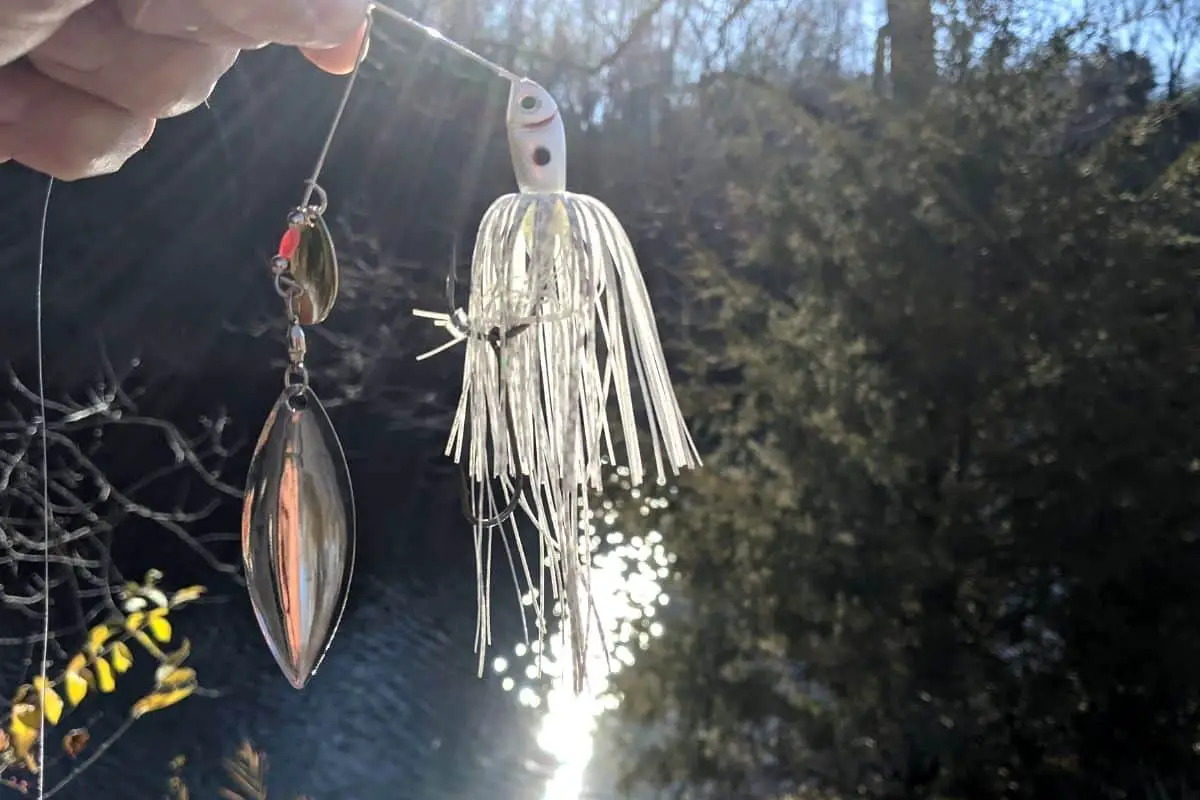The spinnerbait has been a staple in the bass fishing world for decades. There are many color options available to anglers, yet there are only a few you need.
Spinnerbaits that are white, white and chartreuse, silver, and panfish colored are the best choices for bass anglers.
Understanding the conditions and how it impacts color choice is key to making the right spinnerbait color selection.
The Best Conditions for Fishing Spinnerbaits
Spinnerbaits are used for horizontal presentations that cover water.
There are conditions that are best suited for this type of fishing when the bass are more apt to roam and their strike zone will be bigger.
I always look for wind and/or current when fishing spinnerbaits. I prefer overcast days, but if there is wind present a spinnerbait can excel on sunny days as well.
The wind is critical for an important reason – it gets the food chain going.
Fishing wind blown areas is what I always look for. Can I find a shoreline that is pummeled by the wind? Is there an offshore weedbed that the wind is pushing into?
Wind forces microorganisms into specific areas. Small baitfish and other creatures feed on this zooplankton. This draws in larger predators like bass.
When the food chain is active the bass are willing to move farther and cover more water. This is the ideal situation for spinnerbaits.
Understanding the Baitfish in the Waters You Fish and Spinnerbait Color Choice
Always take into consideration the baitfish you have in the waters you are fishing.
Many reservoirs in the south have both threadfin and gizzard shad. Spinnerbaits in whites, grays, and silvers are excellent choices. Many northern natural lakes have minnows and alewives. The same colors work well to imitate those prey species.
My home waters have no shad, but lots of bluegills and crappie. The bass are keyed in on the panfish. While a white spinnerbait still works, a skirt and head design that flashes traditional panfish colorations is a solid choice.
(Here is an article that covers every aspect of spinnerbaits.)
Sunshine and Spinnerbait Color Choice
When the sun is out, selecting colors that flash can draw bass from a distance.
Schools of baitfish often glisten and flash on sunny days. Imitating that flash with our lures can trigger a bass into feeding. Silver blades and translucent skirts are excellent choices if you have these conditions.
When the clouds roll in, opting for a more solid pattern is a good option. A solid white skirt with either silver or painted white blades is worth a try.
When the waters are murky I like to add in some chartreuse. A white and chartreuse spinnerbait has long been a staple of bass professionals.
How to Know if Your Lure Color Choice is Working
This is a question I am often asked. This is the process I go through to decide if my color choice needs altering or not.
How are the bass hitting the lure?
Do they nip at it and are barely getting hooked? Are they only getting the trailer hook? Do they follow and swat at the lure? Or are they aggressively eating it and getting the bait inside their mouth?
Our goal at all times is to have the fish eat the lure aggressively.
If the bass are nipping at the lure and just swatting at it, I will start to adjust my color choice. There are, of course, other factors like depth, speed, presentation, etc., but color selection is where I will start.
There are times when the bass are lethargic and not in the mood to annihilate a lure, but that is what my end goal is. Always.
(Here is an article about lure color selection for dirty water.)
How to Know What Depth to Fish Spinnerbaits
Spinnerbaits like to ride high in the water column. Many times we are bringing our lures above the bass. They no doubt are aware of the blades thumping away, but they may feel the meal is not worth chasing down.
We must get the lure closer to the depth the bass are holding at.
If the waters you fish are clear, then my starting point is to always bring the lure back just out of my sight. This often means tying on a heavier lure or slow-rolling it and banging it into bottom composition.
Bigger bass like to hang where the light penetration dissipates.
When fishing dirtier water, or muddy water, the bass tend to be found shallower than their clear water cousins. This is good news for bass anglers.
Now visible targets are in play and we can really see where we are fishing these bladed lures. Banging and bouncing a spinnerbait into shallow targets and triggering reaction strikes is a bass angler’s paradise.

The Must-Have Spinnerbait Colors
I always carry white, white and chartreuse, silvers or translucent colors, and then an offering that looks like bluegill.
These four color combinations in various blade options will get the job done anywhere.
It is also important to have a few different weight and profile sizes mixed in. There are times when a compact or small frame spinnerbait will outshine a bigger ½ oz model.

The size of the baitfish and prey species guide me in lure size selection.
Good luck out there and be sure to encourage someone today. You never know how you may change their life forever.
Isaiah 6:8

